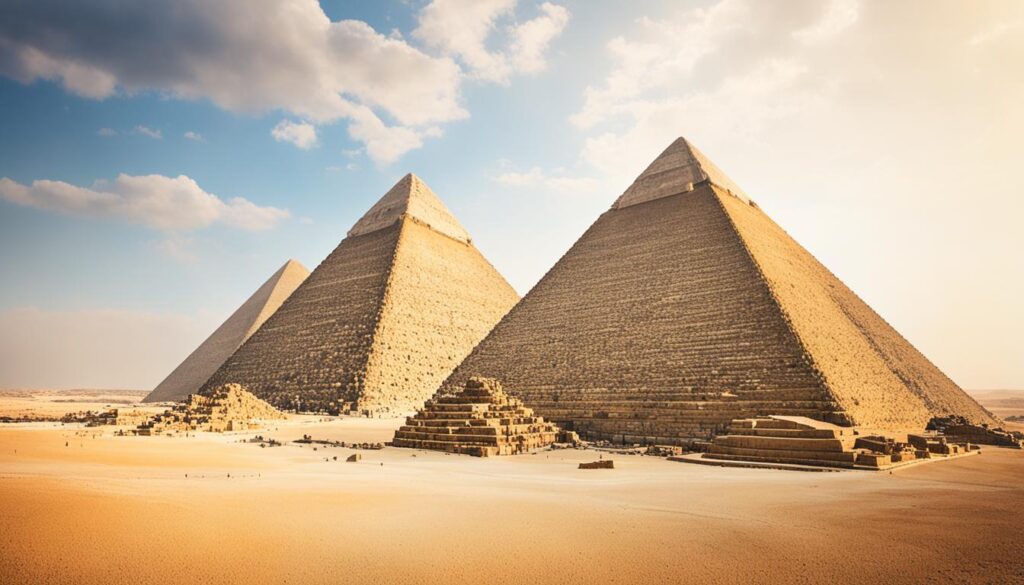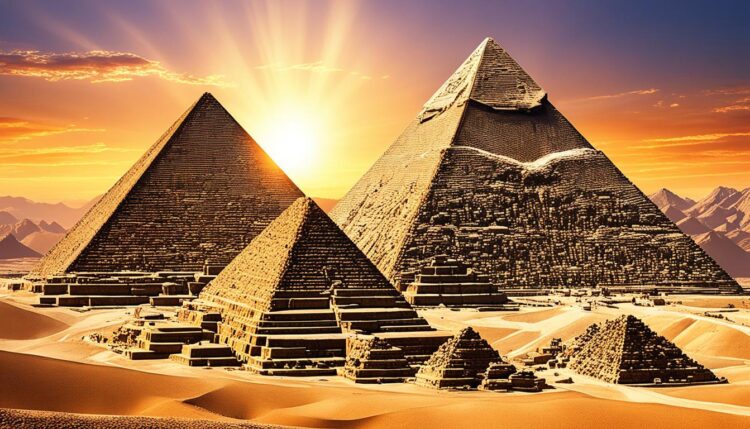How could an edifice built over four millennia ago still command awe and intrigue in an age of skyscrapers and advanced engineering? The Great Pyramid of Giza, an enduring testament to the ingenuity of ancient Egypt, is ensconced on the Giza Plateau and heralded as one of the Seven Wonders of the Ancient World.
This monumental structure continues to mesmerize explorers and scholars alike, embodying the complexities and grandeur of an ancient civilization that has captivated human imagination for centuries. As we delve into its historical significance and architectural brilliance, we will uncover the persistent enigmas that make this colossal pyramid an extraordinary feat of human genius and a beacon from the ancient past.
Historical Background of the Great Pyramid of Giza
Constructed during the reign of Pharaoh Khufu in Egypt’s 4th dynasty around 2560 BCE, the Great Pyramid of Giza marks a pinnacle in ancient Egyptian engineering and culture. This architectural marvel, which stands as one of the Seven Wonders of the ancient world, has fascinated historians and archaeologists alike due to its monumental scale and intricate design.
The Great Pyramid was erected as a royal tomb, embodying both the historical significance and spiritual beliefs of the era. Its construction reflects the complex societal structures and religious convictions that were prevalent during the 4th dynasty of Egypt. The precision in its alignment and structure highlights the advanced knowledge of astronomy and mathematics possessed by the ancient Egyptians.
The historical significance of the Great Pyramid goes beyond its sheer size. As the most enduring of the Seven Wonders, it has survived the test of time, providing a link to the enigmatic past of ancient Egypt. The meticulous planning and massive labor force required to construct this colossal edifice underscore the organizational capabilities and resources of Pharaoh Khufu’s reign.
Encompassing an area of about 13 acres, the pyramid was originally covered in casing stones made of highly polished Tura limestone, making it gleam in the desert sun and visible from great distances. These stones, along with the pyramid’s core, have provided scholars with invaluable insights into the methods and materials used by the ancient Egyptians, further cementing its place in history as a paragon of architectural achievement.
Below is a detailed comparison of key figures related to the Great Pyramid’s construction:
| Aspect | Details |
|---|---|
| Dynasty | 4th Dynasty of Egypt |
| Reign | Pharaoh Khufu |
| Construction Period | Circa 2560 BCE |
| Cultural Significance | Royal Tomb, Symbol of Power |
| Seven Wonders | Yes, Most Enduring |
Architectural Design and Layout
The Great Pyramid of Giza stands as a testament to the exceptional engineering skills of the ancient Egyptians. Its architectural design showcases a remarkable understanding of precision and alignment, reflecting a deep connection to ancient Egyptian astronomy. This section delves into the pyramid’s exterior dimensions and orientation, as well as its intricate inner passages and chambers, highlighting the materials of granite and limestone used in its construction.
Exterior Dimensions and Orientation
The Great Pyramid exhibits extraordinary exterior dimensions with a base originally measuring 755 feet on each side and an awe-inspiring height of 482 feet. Its cardinal orientation is incredibly precise, with each side aligned almost perfectly to the four cardinal points of the compass. These architectural wonders embody the ancient Egyptians’ unprecedented engineering skills and their close observance of ancient Egyptian astronomy.
Inner Passages and Chambers
Inside the pyramid, a labyrinth of passages ascends to a series of chambers, including the Queen’s Chamber and the magnificent King’s Chamber. These inner passages and chambers are a true testament to the advanced engineering skills and ingenuity of the ancient Egyptians. The King’s Chamber, in particular, is constructed with enormous granite blocks, illustrating the monumental effort and resources dedicated to this grand structure. The Grand Gallery, leading up to the King’s Chamber, further accentuates the intricate design and layout that make the Great Pyramid a masterpiece of ancient architecture.
Construction Techniques Used by Ancient Egyptians
The construction methods employed for the Great Pyramid stand as a profound testament to the ancient Egyptians’ architectural ingenuity. Utilizing advanced ancient construction techniques, they managed to move and position millions of heavy limestone blocks with remarkable precision. The intricacies of limestone quarrying played a crucial role, involving the extraction of large blocks from nearby quarries.
One of the most fascinating aspects of the pyramid’s construction is the ramp systems used. Historians and archaeologists have debated various ramp configurations, including straight, zigzagging, and circular ramps. Each theory presents a compelling explanation of how these ramp systems could have facilitated the transport of massive stones to the upper levels of the pyramid.
A key factor in this monumental project was the labor force. Contrary to popular belief, recent evidence suggests that the labor force consisted not of slaves, but of a well-organized team of skilled laborers and craftsmen. This organized workforce contributed significantly to the pyramid’s rapid and efficient construction, displaying an advanced understanding of project management and workforce logistics.
The combined use of innovative tools such as sledges, rollers, and levers underscores the sophistication of these ancient construction techniques. By employing these methods, the ancient Egyptians were able to achieve the level of precision and durability that continues to inspire modern engineering and construction practices. Despite the considerable advancements made in understanding these methods, many aspects of the pyramid’s construction still remain enshrouded in mystery, sparking ongoing research and fascination.
The Role of Pharaoh Khufu in Constructing the Pyramid
Pharaoh Khufu, also known as Cheops, was an influential figure of Egypt’s 4th dynasty, whose vision and command transformed the Giza Plateau. Ascending to power as an ancient ruler, Khufu embarked on a monumental project that would not only immortalize his reign but also epitomize the zenith of Egyptian architectural prowess.
Khufu’s initiative in constructing the Great Pyramid was underpinned by both strategic and symbolic motivations. Positioned as the emblem of his divine authority, the pyramid was meticulously designed to align with celestial bodies, reinforcing the belief in his divine right to rule. It served as a testament to his desire to not only showcase his power but ensure his name was etched in history.
| Aspect | Description |
|---|---|
| Royal Vision | Pharaoh Khufu’s ambition manifesting in the pyramid’s grand design. |
| Cultural Zenith | The era of construction symbolizing the peak of the 4th dynasty’s achievements. |
| Symbolism | The alignment with celestial bodies to cement Khufu’s divine status. |
Cheops adopted advanced engineering techniques for the pyramid’s construction, reflecting his proficiency and the technological advances of the period. Through a blend of statecraft and divine symbolism, Pharaoh Khufu’s enduring legacy is immortalized in the colossal structure that stands testament to his reign and the heights of ancient Egyptian civilization.
Comparison with Other Pyramids of Giza
The Giza pyramid complex is a monumental testament to the architectural prowess of ancient Egyptians. It comprises the pyramids attributed to Khufu, Khafre, and Menkaure. An architectural comparison of these iconic structures reveals unique features and dimensions.
Khafre’s Pyramid
Also known as the Pyramid of Khafre, this structure is the second tallest and second largest of the Giza pyramids. Despite appearing taller due to its elevated location on the Giza plateau, its construction is slightly less grand than the Great Pyramid of Khufu. Khafre’s pyramid features a well-preserved complex, including the Great Sphinx, which adds to its historical significance and allure.
Menkaure’s Pyramid
In stark architectural comparison, the Pyramid of Menkaure is the smallest among the three, reflecting a shift in construction scale and resources. Despite its modest dimensions, the meticulous craftsmanship is evident, with intricate temple complexes accompanying the pyramid. This structure exemplifies the evolution of pyramid construction techniques over time within the pyramid complex.
| Pyramid | Height | Base | Significant Features |
|---|---|---|---|
| Great Pyramid of Khufu | 146.6 meters (originally) | 230.4 meters | Largest pyramid; complex internal chambers |
| Pyramid of Khafre | 136.4 meters | 215.5 meters | Includes the Great Sphinx |
| Pyramid of Menkaure | 65 meters | 102.2 meters | Smaller; detailed temples |
Mysteries and Theories Surrounding the Pyramid
The Great Pyramid of Giza is shrouded in numerous pyramid mysteries that continue to spark global intrigue. One of the most captivating mysteries is the potential existence of hidden chambers within the pyramid. Advanced technologies, including ground-penetrating radar and muon scans, have revealed anomalies in the structure that some experts believe could be unexplored rooms. These discoveries amplify the allure and enigma of the Great Pyramid.
Another layer of fascination involves ancient alien theories that speculate how the technology to construct such an architectural marvel could have been extraterrestrial in origin. Proponents suggest that the precision and enormity of the project might have required advanced engineering knowledge far beyond what was available to ancient Egyptians. Such theories, though controversial, have captivated imaginations and fueled discussions in both academic and popular spheres.
Moreover, the pyramid’s design is often analyzed for religious symbolism. Many scholars point to the alignment of the pyramid’s sides with the cardinal points and its internal architecture as being imbued with deep spiritual and astronomical significance. The positioning of the pyramid is thought to align with specific star constellations, such as Orion’s Belt, which held religious importance in ancient Egyptian culture.
The intersection of these theories, from potential hidden chambers to religious symbolism and ancient alien theories, creates a rich tapestry of curiosity that continues to draw both scholars and enthusiasts alike. The pyramid mysteries remain an open field for inquiry, inviting new explorations and perspectives that deepen our appreciation of this ancient wonder.
Archaeological Discoveries at the Site
The Giza plateau excavations have continually yielded remarkable insights, further enlightening the world about the construction and purpose of the Great Pyramid of Giza. Rich with history and hidden marvels, the site provides substantial evidence of its ancient origins and the brilliance of its creators.
Laborer’s Graffiti
One of the fascinating archaeological findings was the discovery of graffiti left by laborers. These markings, inscribed deep within the pyramid, serve as irrefutable proof that these workers, under the rule of Pharaoh Khufu, played a crucial role in the construction. The hieroglyphic inscriptions found here often indicated the names of work gangs, adding a human element to the grand narrative of the pyramid.
Hidden Corridors
Another significant breakthrough in the Giza plateau excavations was the uncovering of concealed passageways within the pyramid. Using modern scanning technology, archaeologists have identified hidden corridors that were previously undetectable. These passages not only shed light on the remarkable engineering techniques of ancient Egyptians but also provide new avenues for understanding the pyramid’s function and structure.
The Great Sphinx and Its Connection to the Pyramid
The Great Sphinx, a monumental limestone statue, stands as a vigilant guardian of Giza. Its lion’s body and human head, often interpreted as the pharaoh’s visage, symbolize both strength and wisdom. This mythical structure, with its majestic and enigmatic aura, is deeply intertwined with the Great Pyramid of Giza, creating a harmonious blend of mythology and sovereignty on the Giza plateau.
Over the centuries, the Great Sphinx has captured the imaginations of historians, archaeologists, and visitors. Geographically, it faces the sunrise, which some scholars believe signifies its protective role over the tombs and treasures of the pyramids. Symbolically, the alignment and proximity of the Sphinx to the Great Pyramid illustrate the interconnectedness of these colossal structures, each contributing to the overarching narrative of ancient Egyptian grandeur.
The exact purpose and builder of the Great Sphinx remain subjects of debate, with prominent theories suggesting it was constructed during the reign of Pharaoh Khafre. This connection aligns the pharaoh’s visage not only with the Sphinx but also with the towering pyramids nearby, reinforcing the ruler’s enduring legacy amidst these mythical structures.
By examining these enduring symbols—the Great Sphinx and the Great Pyramid—we gain insight into the ancient civilization’s architectural prowess, religious fervor, and the seamless integration of art and engineering. This combination of elements solidifies the enigmatic yet majestic site as a focal point of human history and achievement.
The Great Pyramid of Giza as a UNESCO World Heritage Site
Since its UNESCO recognition in 1979, the Great Pyramid of Giza has stood as a testament to humanity’s ingenuity and dedication to cultural preservation. This ancient marvel enjoys an unparalleled status as a world heritage site, symbolizing not just the architectural prowess of ancient Egyptians but also the universal value it holds for people across the globe.

The Great Pyramid’s inclusion in the world heritage list underscores its cultural significance. Recognized for its exceptional attributes, the pyramid exemplifies how ancient civilizations have shaped modern cultural understanding and appreciation. The broader implications of such a monument being a focal point of UNESCO recognition resonate deeply within the global community, emphasizing the importance of conserving these treasures.
Efforts to maintain and protect this ancient structure are a priority for both domestic and international bodies. Conservation efforts are regularly undertaken to safeguard the pyramid’s integrity against the ravages of time and environmental factors. These conservation efforts are vital to ensure that future generations can continue to marvel at this cornerstone of humanity’s architectural achievements.
| Aspect | Details |
|---|---|
| Year of UNESCO Recognition | 1979 |
| Primary Focus of UNESCO Listing | Cultural Significance |
| Conservation Efforts | Ongoing preservation and restoration projects |
| Global Impact | Symbol of human ingenuity and cultural heritage |
The Great Pyramid of Giza’s place on the UNESCO world heritage list is a powerful reminder of the universal value it holds. Through global cooperation and diligent efforts, this heritage site continues to captivate imaginations and inspire awe, ensuring that its cultural significance endures for centuries to come.
Conclusion
The Great Pyramid of Giza stands as an architectural marvel, a pinnacle of human ingenuity and ambition from ancient Egypt. This monument, constructed over four millennia ago, continues to captivate the imagination of people around the world with its scale, precision, and sheer endurance. Serving as both a testament to Pharaoh Khufu’s vision and the labor of countless workers, the Pyramid is more than just a stone edifice; it is a symbol of our enduring legacy in stone.
Throughout our exploration, we’ve delved into its historical background, architectural design, and construction techniques, each revealing layers of ingenuity and resourcefulness. From its meticulously-oriented exterior to the hidden chambers and corridors that continue to intrigue archaeologists, the Great Pyramid remains a subject of ceaseless study and speculation. The roles of neighboring pyramids and the enigmatic Great Sphinx further enrich its fascinating context within the realm of ancient Egypt.
As a UNESCO World Heritage site, the Great Pyramid of Giza embodies the profound cultural and historical significance that transcends time. It stands as a beacon showcasing human potential and creativity. Its unsolved mysteries and remarkable engineering feats immortalize it as one of the world’s greatest wonders. The Great Pyramid’s enduring legacy will inevitably inspire future generations to explore, innovate, and marvel at the achievements of our predecessors.













